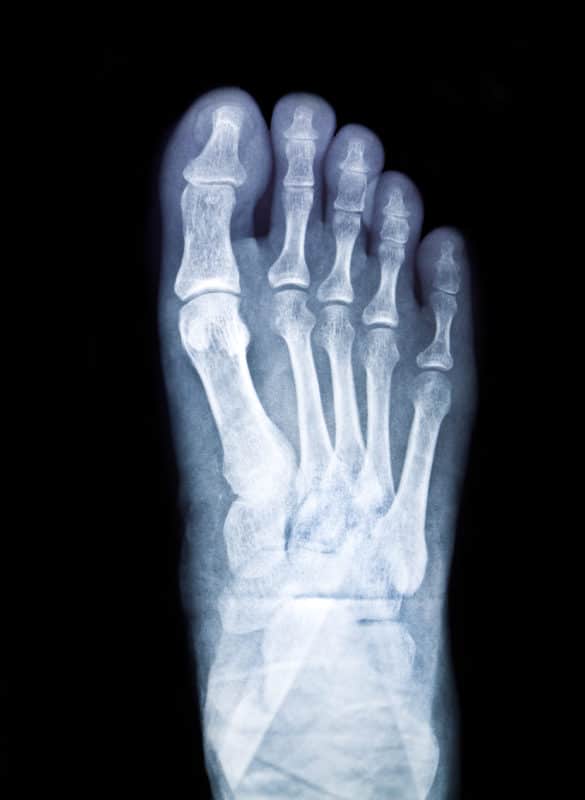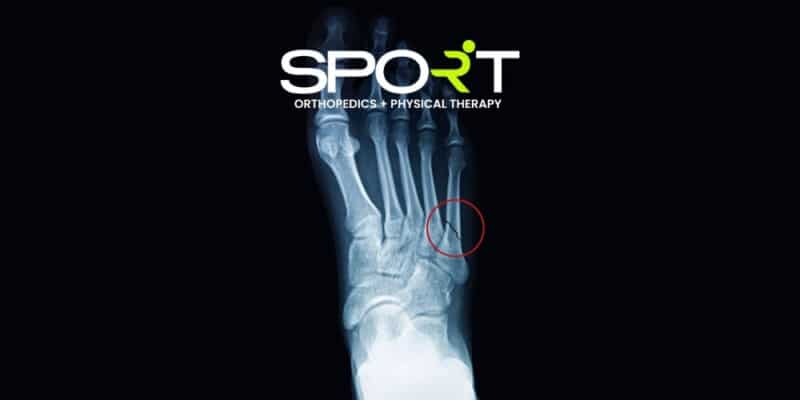Jones Fracture Treatment in Dallas & Frisco
Foot Pain on Top of Foot, Top of Foot Pain
Why Does the Top of My Foot Hurt?
A Jones fracture, named for an early 20th-century physician who reported on his own injury, is an injury that occurs in the metatarsal bone on the outside of your foot, in the area of the pinkie toe. These fractures are very common in athletes, particularly basketball and football players. People with high-arched feet are more susceptible to Jones fractures than people with flatter feet.
At SPORT Orthopedics + Physical Therapy, our Dallas orthopedic specialists see Jones fractures on a regular basis. If you’re an athlete looking for the best treatment Frisco or Dallas has to offer, you’ve come to the right place. We also offer foot pain treatment, treatment for a sprained toe, foot fracture treatment, and much more. To schedule an appointment with a talented orthopaedic surgeon, call our office at 469-200-2832 today.
Foot Anatomy
Your feet are much more complicated and flexible than you might think. The anatomy of the foot consists of many bones, ligaments, muscles, joints, and other essential soft tissues. All of these structures work in tandem to allow us to stand, walk, jog, run, jump, and so much more. There are three main sections of the foot: the forefoot, midfoot, and hindfoot.
- Forefoot: This area contains the five toes, which are called phalanges. The longer bones that connect our toes to the midfoot are called the metatarsals.
- Midfoot: This area forms the arch of the foot. It contains three main bones, the navicular bone, the cuboid bone, and the cuneiform bones.
- Hindfoot: This area forms both the heel and the ankle of the foot. The three bones that come together to form the ankle are the talus bone, the tibia, and the fibula. The heel is formed by the largest bone in the foot, the calcaneus.
Importantly, the bones aren’t the only structures that allow the feet to move the way they do. Groups of muscles, tendons, and ligaments work together with the bones, allowing us to move and balance ourselves. Think of the strong Achilles tendon that connects your calf muscle to your heel. This one tendon is essential for people to be able to jump, run, stand on their toes, and so much more. When even one area of the foot suffers an injury, this can lead to not only pain, but also mobility problems.

What Is a Jones Fracture?

A Jones fracture occurs in the fifth metatarsal bone. This is located on the outside of the foot. Metatarsals are the bones that connect your ankle to your toes. The fifth metatarsal is slightly different from the other metatarsals, as it bulges at the base, while the other metatarsals do not.
A Jones Fracture is typically a transverse fracture. This means the fracture occurs what we would think of as horizontally, perpendicular to the long axis of the bone.
Most of the time, a Jones Fracture occurs in a part of the bone that is difficult to heal. It most often occurs in a junction of the bone, where the bone transitions from dense to spongy.
Because of the limited blood flow to this area, healing a Jones fracture can be a long and arduous process.
Jones Fracture vs Avulsion Fracture
It is common for people to confuse Jones fractures with avulsion fractures. While they both involve a fifth metatarsal fracture, the small differences between the two make all the difference. The fifth metatarsal bone lies between the pinky toe and the rest of your foot. Because it is a relatively long bone, it has three zones that tell doctors exactly where the break occurred.
- Zone 1 fractures occur at the base of the fifth metatarsal, where it meets the rest of the foot. These breaks can be called tennis fractures, avulsion fractures, pseudo-Jones fractures, or even dancer fractures.
- Zone 2 fractures occur in the middle of the bone. These are Jones fractures. Generally, they have a higher risk of complications and usually need surgery.
- Zone 3 fractures occur at the opposite end of the bone from Zone 1, closer to the pinky toe. These are usually classified as stress fractures.
What Causes a Jones Fracture?

A Jones fracture can either result from overuse of the fifth metatarsal area, or from trauma to the area. If they occur as a result of trauma, the injury is usually an inversion-type sprain, where the foot is twisted inward towards the other foot. This is the same type of injury that can result in an ankle fracture.
Jones fractures caused by overuse occur when repeated pressure is placed on the outer edge of the foot. This is why people with high arches are more susceptible to these fractures, as more pressure is placed on the outside of the foot.
Risk factors for Jones fractures include the following.
- Putting more stress on your feet than the average person (think tennis players, dancers, other athletes, and workers who are on their feet a lot)
- Men around the age of 30
- Women around and over the age of 70
- Having osteoporosis
How Common Are Jones Fractures?
Jones fractures are actually one of the most common foot bone fractures. Fifth metatarsal fractures, in general, are fairly common in certain types of people, such as dancers and athletes. However, anyone can suffer a Jones fracture at any time. You could suffer this type of broken bone simply from walking on uneven surfaces or from intense physical activity.
Unfortunately, this type of fifth metatarsal fracture often requires surgery. Without proper treatment, you may experience slow bone healing, difficulty walking, pain, or other complications.
What Are Jones Fracture Symptoms?
A Jones fracture will have many of the same symptoms as other types of fractures. A person may or may not realize a fracture has occurred immediately; if the injury is a result of overuse or repetitive stress on the bones, the symptoms may come to light more gradually.
Some of the more common symptoms include:
- Pain and swelling on the outside of the foot at the base of the little toe
- Problems walking
- Bruising
- Tenderness
- Bumps or deformities on the foot
How Is a Jones Fracture Diagnosed?
Dr. Berry will be able to determine if you have a Jones fracture or some other type of injury to the metatarsal. He will conduct a physical examination by pressing areas of the foot to assess the location of the pain.
Dr. Berry or Dr. O’Brien will also question you about when and how your pain started. X-rays and other imaging scans may be necessary to confirm the diagnosis.
Getting the diagnosis correct is absolutely essential, as the precise nature of the diagnosis heavily affects treatment and management. It can be difficult to know how to tell if your foot is fractured, but speaking with an orthopedic specialist can help.
How Is a Jones Fracture Treated?

The treatment of a Jones fracture depends mostly on the severity of the fracture itself. There are several methods you can employ to manage the pain and begin treating the injury, even before seeing a doctor.
For instance, you can use the RICE method to reduce pain and swelling. The RICE method involves:
- Resting the injury
- Icing painful or swollen areas
- Compressing the affected area with an elastic wrapping
- Elevating the injured foot above the level of the heart
This can help manage your pain and prevent the fracture from worsening while you await treatment. If at all possible, treatment will be nonsurgical.
It’s important to note that a Jones fracture can be described as displaced or non-displaced. Displaced fractures basically move out of alignment from their original positions. Non-displaced fractures don’t move far enough to be out of alignment. Displaced fractures tend to be more severe and have a higher chance of requiring surgery.
Nonsurgical Jones Fracture Treatment
Depending on the severity of metatarsal fractures, they may or may not require surgery. For milder breaks, your doctor will likely begin with conservative treatments. Let’s say that your break is fairly mild and requires no foot surgery.
Your orthopedic surgeon will likely recommend that you wear a boot or a cast while your fracture heals. This will keep the injured foot in place while the bone heals properly. You will wear the cast or boot for around six to eight weeks with regular checkups to ensure that the healing process goes smoothly.
You may also need a closed reduction before you get your boot or cast, which is a form of non-surgical treatment done under general anesthesia. Your doctor will administer a local anesthetic to numb your injured foot, as well as give you sedatives to relax your body. Then, you will be placed under general anesthesia.
Your doctor will then manipulate your injured foot from the outside in order to realign any displaced bones. This is followed up with a cast or boot.
Jones Fracture Surgery
There are two main forms of fifth metatarsal fracture surgery: internal fixation and bone grafting. Jones fractures treated with surgery tend to be more severe.
- Internal fixation: After setting your bones in place, your surgeon will secure them in the proper position. They will do this by using metal rods, plates, screws, or pins and wires.
- Bone graft: For particularly serious breaks, your doctor may recommend a graft if there are problems with the bone healing. This surgical procedure involves adding donor bone tissue in order to rejoin the original bone. They will fix the graft in place with internal fixation for the healing process. These grafts can come from a few different places, including your own body, another donor, or from an artificial implant.
Most patients can go home the same day they have their surgery. However, they will need someone to drive them home. It’s important to keep as much weight off your foot as possible for about eight weeks to encourage healing. You’ll also wear a cast or a boot during that period of time.
Can a Jones Fracture Heal Without Surgery?
You will likely need to wear a cast or walking boot for 6 to 8 weeks to allow the Jones fracture time to heal. Because of the location of the fracture, it can sometimes be difficult to heal. The risk of re-injury is relatively high, so your orthopedic surgeon will be able to advise you on recovery time for your specific injury.
Do I Need Surgery for a Jones Fracture?
When athletes suffer a Jones fracture, the recommended treatment is usually an ankle arthroscopic surgery. During surgery, a small incision will be made, and a screw, rod, or plate will be inserted through the site of the fracture, squeezing the ends of the fracture together.
Occasionally, a bone graft may be necessary, if the person has experienced repeated fractures.
What Is the Average Jones Fracture Healing Time?

With nonsurgical treatment, a Jones Fracture may take up to 12 weeks to heal, though the average recovery time is more like 6 to 8 weeks.
With a surgical approach, a person who has suffered a Jones fracture can expect a return to all activities in about 4 months. A doctor will likely recommend physical therapy to strengthen the muscles and ligaments of the foot during this time. If the fracture required bone grafting during treatment, recovery time could be significantly longer, sometimes taking up to 6 or 8 months.
Can You Still Walk With a Jones Fracture?
In general, we advise patients to avoid putting weight on the affected leg for around six to eight weeks. Many of these patients also have a cast or a boot, which helps the bone heal correctly. If you have an active lifestyle, we highly recommend speaking with your orthopedic surgeon about when you can return to sports and other activities. They will provide you with professional medical advice on when you can get back in the game, as well as how to avoid reinjury.
Get Jones Fracture Treatment at SPORT Orthopedics + Physical Therapy
At SPORT Orthopedics + Physical Therapy, we take great pride in helping Dallas and Frisco residents overcome their injuries and pain. We understand how frustrating it can be to sit on the sidelines while your injuries heal slowly. That’s why our providers offer only the best in orthopedic care. We make sure that your healing process is as smooth and pain-free as possible so that you can get back to your active lifestyle. If you suffered a foot injury and you require surgery, schedule an appointment with SPORT today. Call our office at 469-200-2832 to make your appointment or schedule online with us.


